In reviewing science books, we have found the best books have engaging and fascinating information and—perhaps more important—encourage the interest of young readers in scientific observation and investigation. Some of these books integrate science with cross-curricular topics including culture, history, and preservation of the quality of natural environments.
Ages 4–8
Bilby: Secrets of an Australian Marsupial. Edel Wignell. Ill. Mark Jackson. 2015. Candlewick Press.
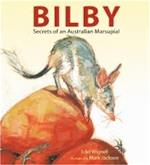 Written partly as a narrative, the book recounts the life of Bilby, a female bilby, an endangered nocturnal marsupial who creates long, narrow, and steep burrows deep in the earth for protection. Bilby gives birth to Baby Bilby in one of these burrows. Written partly as an exposition, the pages include information related to the life cycle of the marsupial and its survival strategies for living in the desert. This small animal’s rabbit-like ears, long nose, and long, crested tail give it a distinct appearance. Double-spread illustrations, rendered in paint and colored pencil, show Bilby and her son in their desert habitat.
Written partly as a narrative, the book recounts the life of Bilby, a female bilby, an endangered nocturnal marsupial who creates long, narrow, and steep burrows deep in the earth for protection. Bilby gives birth to Baby Bilby in one of these burrows. Written partly as an exposition, the pages include information related to the life cycle of the marsupial and its survival strategies for living in the desert. This small animal’s rabbit-like ears, long nose, and long, crested tail give it a distinct appearance. Double-spread illustrations, rendered in paint and colored pencil, show Bilby and her son in their desert habitat.
—SW
High Tide for Horseshoe Crabs. Lisa Kahn Schnell. Ill. Alan Marks. 2015. Charlesbridge.
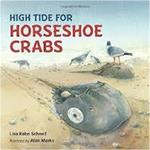 Horseshoe crabs appear on shores of the eastern United States, notably the Delaware Bay, to lay eggs, many of which become food for migrating birds that appear at the same time. A narrative text and dramatic double-spread watercolor and pencil illustrations present the life cycle of the arthropod in the context of the research done by scientists and volunteers who tag the crabs to discern their migratory behavior and life span. Back matter includes information on the evolution and biology of the horseshoe crab and on its importance in the food chain and for humans, such as the use of its blue blood in a test to ensure that medicines and medical devices used in humans are free of harmful bacteria. Endpapers present labeled diagrams of dorsal and ventral views of the horseshoe crab.
Horseshoe crabs appear on shores of the eastern United States, notably the Delaware Bay, to lay eggs, many of which become food for migrating birds that appear at the same time. A narrative text and dramatic double-spread watercolor and pencil illustrations present the life cycle of the arthropod in the context of the research done by scientists and volunteers who tag the crabs to discern their migratory behavior and life span. Back matter includes information on the evolution and biology of the horseshoe crab and on its importance in the food chain and for humans, such as the use of its blue blood in a test to ensure that medicines and medical devices used in humans are free of harmful bacteria. Endpapers present labeled diagrams of dorsal and ventral views of the horseshoe crab.
—SW
How to Swallow a Pig: Step-by-Step Advice from the Animal Kingdom. Steve Jenkins & Robin Page. Ill. Steve Jenkins. 2015. Houghton Mifflin Harcourt.
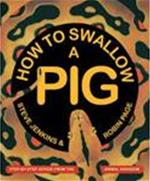 Readers of Jenkins and Page’s how-to guide learn about animal behavior from the step-by-step advice of 18 animals, from a humpback whale telling how to trap fish in five steps to a python telling how to swallow a pig in six steps. Jenkins’ signature torn- and cut-paper collages accompany the instructions that are stated clearly and with humor. For example, a lesson on how to woo a ewe like a mountain sheep comes with a warning that following a bighorn ram’s advice could give you a bad headache. The appendix includes thumbnail sketches of each advice-giving animal.
Readers of Jenkins and Page’s how-to guide learn about animal behavior from the step-by-step advice of 18 animals, from a humpback whale telling how to trap fish in five steps to a python telling how to swallow a pig in six steps. Jenkins’ signature torn- and cut-paper collages accompany the instructions that are stated clearly and with humor. For example, a lesson on how to woo a ewe like a mountain sheep comes with a warning that following a bighorn ram’s advice could give you a bad headache. The appendix includes thumbnail sketches of each advice-giving animal.
—CA
Ages 9–11
Birdology: 30 Activities and Observations for Exploring the World of Birds.Monica Russo. Ill. Kevin Byron. 2015. Chicago Review Press.
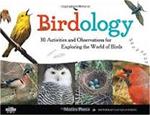 As much as this book provides projects of observation related to the study of birds, it includes information on geography, the characteristics of birds, bird identification, the migratory and feeding habits of birds, the work that scientists and volunteers undertake to study birds, and efforts to protect birds. Sidebars describe “Look For and Try This!” activities. The back matter includes a glossary and list of bird orders, a teacher’s guide with whole class and individual activities, online resources, a bibliography, and an index.
As much as this book provides projects of observation related to the study of birds, it includes information on geography, the characteristics of birds, bird identification, the migratory and feeding habits of birds, the work that scientists and volunteers undertake to study birds, and efforts to protect birds. Sidebars describe “Look For and Try This!” activities. The back matter includes a glossary and list of bird orders, a teacher’s guide with whole class and individual activities, online resources, a bibliography, and an index.
—SW
Sand Swimmers: The Secret Life of Australia’s Dead Heart. Narelle Oliver. 2015. Candlewick Press.
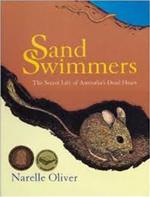 Oliver tells the story of the adaptation and survival of animals in the harsh desert wilderness in Central Australia known as Dead Heart. Parallel stories tell of the Aboriginal peoples, whose discovery and understanding of the plants and hidden animals of the desert enabled them to live in the region, and of the first European explorers, who dreamed of discovering an inland sea but found only huge waves of sand and described the region as lifeless. Oliver’s illustrations, created with linocut, colored pencil, and linocut rubbings, provide dramatic desertscapes and intricately detailed portraits of the wildlife that lives in Australia’s Dead Heart.
Oliver tells the story of the adaptation and survival of animals in the harsh desert wilderness in Central Australia known as Dead Heart. Parallel stories tell of the Aboriginal peoples, whose discovery and understanding of the plants and hidden animals of the desert enabled them to live in the region, and of the first European explorers, who dreamed of discovering an inland sea but found only huge waves of sand and described the region as lifeless. Oliver’s illustrations, created with linocut, colored pencil, and linocut rubbings, provide dramatic desertscapes and intricately detailed portraits of the wildlife that lives in Australia’s Dead Heart.
—CA
Welcome to New Zealand: A Nature Journal. Sandra Morris. 2015. Candlewick Press.
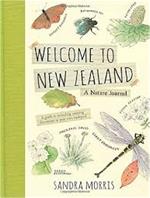 Following an introduction to keeping an illustrated journal of observations and thoughts about the natural world, including notes on creating a seasonal color wheel and adding creative hand lettering, Morris takes readers on a series of nature walks in New Zealand: garden, path in a park, wetlands, city street, countryside, forest, mountain, beach, and zoo. Her mixed media drawings and comments introduce readers to the fauna and flora of New Zealand. Morris’ journal may also inspire readers to explore their surroundings and create their own nature journals. Back matter includes a glossary, an index, and a bibliography of nature guides to New Zealand and books on keeping journals.
Following an introduction to keeping an illustrated journal of observations and thoughts about the natural world, including notes on creating a seasonal color wheel and adding creative hand lettering, Morris takes readers on a series of nature walks in New Zealand: garden, path in a park, wetlands, city street, countryside, forest, mountain, beach, and zoo. Her mixed media drawings and comments introduce readers to the fauna and flora of New Zealand. Morris’ journal may also inspire readers to explore their surroundings and create their own nature journals. Back matter includes a glossary, an index, and a bibliography of nature guides to New Zealand and books on keeping journals.
—CA
Ages 12–14
The Great Monkey Rescue: Saving the Golden Lion Tamarins. Sandra Markle. 2015. Millbrook/Lerner.
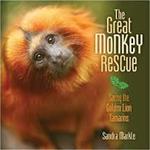 Markle chronicles efforts to save the golden lion tamarin, a species of squirrel-sized monkeys native to Brazil’s Atlantic Forest. With the increasing destruction of its habitat, the tamarin was nearly extinct by the 1960s. Zoos were unsuccessful in raising tamarins until scientists learned that each tamarin family group requires its own territory. Separate housing of pairs of tamarins led to successful breeding programs and, by the 1990s, zoo-born monkeys were being trained for reintroduction into Brazil. As reforestation and protection of habitat projects continue in Brazil, there is hope for the survival of the golden lion tamarin. Captioned close-up photographs of tamarins, maps, and extensive back matter help tell the story of “the great monkey rescue.”
Markle chronicles efforts to save the golden lion tamarin, a species of squirrel-sized monkeys native to Brazil’s Atlantic Forest. With the increasing destruction of its habitat, the tamarin was nearly extinct by the 1960s. Zoos were unsuccessful in raising tamarins until scientists learned that each tamarin family group requires its own territory. Separate housing of pairs of tamarins led to successful breeding programs and, by the 1990s, zoo-born monkeys were being trained for reintroduction into Brazil. As reforestation and protection of habitat projects continue in Brazil, there is hope for the survival of the golden lion tamarin. Captioned close-up photographs of tamarins, maps, and extensive back matter help tell the story of “the great monkey rescue.”
—CA
Welcome to Mars: Making a Home on the Red Planet. Buzz Aldrin (with Marianne J. Dyson). 2015. National Geographic Kids.
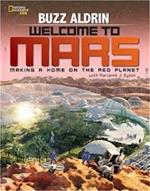 With his introductory section on what’s needed to get to Mars, Aldrin describes the exploration of Mars over the last four decades, the characteristics of Mars that dispel myths about the planet, the spacecraft needed to transport people and materials to Mars, and the process of building an environment to support human communities on the planet. Throughout the book are many activities to illustrate the principles of astrophysics described in the text. The book includes two timelines: one related to the exploration of Mars and a hypothetical one showing centuries of settlement during which settlers thicken the air and promote the production of water to sustain life on the planet. Back matter includes a glossary and resources for further reading.
With his introductory section on what’s needed to get to Mars, Aldrin describes the exploration of Mars over the last four decades, the characteristics of Mars that dispel myths about the planet, the spacecraft needed to transport people and materials to Mars, and the process of building an environment to support human communities on the planet. Throughout the book are many activities to illustrate the principles of astrophysics described in the text. The book includes two timelines: one related to the exploration of Mars and a hypothetical one showing centuries of settlement during which settlers thicken the air and promote the production of water to sustain life on the planet. Back matter includes a glossary and resources for further reading.
—SW
When the Earth Shakes: Earthquakes, Volcanoes, and Tsunamis. Simon Winchester. 2015. Smithsonian/Viking/Penguin.
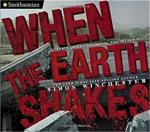 Geologist, explorer, and writer Simon Winchester tells the intriguing story of the three types of catastrophes caused by violent movements within the earth: earthquakes, volcanic eruptions, and tsunamis. Using examples of natural disasters such as the Great San Francisco Earthquake and Fire of 1906, the titanic eruptions of Krakatoa in 1883, and the devastating Sumatra-Andaman Tsunami on Dec. 26, 2004, Winchester explores what happens “when the earth shakes.” Stunning captioned photographs and insets with diagrams and maps supplement Winchester’s engaging account of earthquakes, volcanoes, and tsunamis and the work of scientists to understand the why and how of these natural disasters. Back matter includes recommended reading, viewing, and listening resources and an extensive index to the text and illustrations.
Geologist, explorer, and writer Simon Winchester tells the intriguing story of the three types of catastrophes caused by violent movements within the earth: earthquakes, volcanic eruptions, and tsunamis. Using examples of natural disasters such as the Great San Francisco Earthquake and Fire of 1906, the titanic eruptions of Krakatoa in 1883, and the devastating Sumatra-Andaman Tsunami on Dec. 26, 2004, Winchester explores what happens “when the earth shakes.” Stunning captioned photographs and insets with diagrams and maps supplement Winchester’s engaging account of earthquakes, volcanoes, and tsunamis and the work of scientists to understand the why and how of these natural disasters. Back matter includes recommended reading, viewing, and listening resources and an extensive index to the text and illustrations.
—CA
Ages 15+
Chocolate: Sweet Science & Dark Secrets of the World’s Favorite Treat. Kay Frydenborg. 2015. Houghton Mifflin Harcourt.
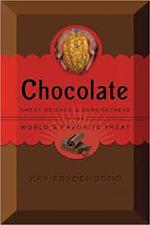 Integrating a history of the civilizations of Central and South America with the history and business of chocolate production in the United States, Frydenborg describes the science involved in understanding the evolution and cultivation of the cacao tree and the process of making cocoa from the seeds of the cacao plant. She follows the work of individual farmers in the mountains of countries in South America, explaining new understanding about cacao cultivation that contradicts the knowledge scientists and farmers previously had. Throughout the book are recipes for uses of cocoa from spiced drinks to confections and cakes. The back matter includes a timeline on chocolate, an annotated list of websites, and references.
Integrating a history of the civilizations of Central and South America with the history and business of chocolate production in the United States, Frydenborg describes the science involved in understanding the evolution and cultivation of the cacao tree and the process of making cocoa from the seeds of the cacao plant. She follows the work of individual farmers in the mountains of countries in South America, explaining new understanding about cacao cultivation that contradicts the knowledge scientists and farmers previously had. Throughout the book are recipes for uses of cocoa from spiced drinks to confections and cakes. The back matter includes a timeline on chocolate, an annotated list of websites, and references.
—SW
Fatal Fever: Tracking Down Typhoid Mary. Gail Jarrow. 2015. Calkins Creek/Highlights.
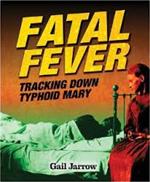 Jarrow’s account of the medical mystery of typhoid outbreaks in the New York City area starting in 1912 is from the perspective of George Soper’s work, a sanitation engineer who tracked down Mary Mallon to solvean earlier typhoid outbreak in Ithaca in 1903. Jarrow explains the biology of the disease and recounts the life of Mary Mallon, a cook who was a healthy typhoid carrier, whose story is also told in the biography Terrible Typhoid Mary by Susan Campbell Bartoletti (2015). Jarrow also explores public health practices of the early 20th century as she presents the life of a second person significant in Mary Mallon’s case, Sarah J. Baker, who was a public health official in the tenements of New York City. In providing context for the events, archival photographs help to make this book engaging. The back matter includes a list of well-known individuals in American history who had typhoid, a glossary, an author’s note, a bibliography, and an index.
Jarrow’s account of the medical mystery of typhoid outbreaks in the New York City area starting in 1912 is from the perspective of George Soper’s work, a sanitation engineer who tracked down Mary Mallon to solvean earlier typhoid outbreak in Ithaca in 1903. Jarrow explains the biology of the disease and recounts the life of Mary Mallon, a cook who was a healthy typhoid carrier, whose story is also told in the biography Terrible Typhoid Mary by Susan Campbell Bartoletti (2015). Jarrow also explores public health practices of the early 20th century as she presents the life of a second person significant in Mary Mallon’s case, Sarah J. Baker, who was a public health official in the tenements of New York City. In providing context for the events, archival photographs help to make this book engaging. The back matter includes a list of well-known individuals in American history who had typhoid, a glossary, an author’s note, a bibliography, and an index.
—SW
Inside Biosphere 2: Earth Science Under Glass. (Scientists in the Field). Mary Kay Carson. Ill. Tom Uhlman. 2015. Houghton Mifflin Harcourt.
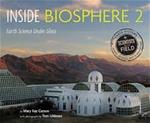 Following an introduction to the original 1991–1993 biosphere residential experiment in the desert near Tuscon, AZ, a closed ecological system in which a team of eight men and women, doctors, scientists, and engineers lived, this book describes the research since the 1990s of four scientists. Four created environments (a rain forest, an ocean, savannah, and a hillside) are laboratories in which researchers can study natural phenomena such as the water cycle, climate change, and the creation of soil from rock under controlled conditions. Throughout the book, numerous photographs depict the research and the environment, visitors who come to observe, and students from nearby schools making scientific measurements as well as photographs of the earlier biospherians at work.
Following an introduction to the original 1991–1993 biosphere residential experiment in the desert near Tuscon, AZ, a closed ecological system in which a team of eight men and women, doctors, scientists, and engineers lived, this book describes the research since the 1990s of four scientists. Four created environments (a rain forest, an ocean, savannah, and a hillside) are laboratories in which researchers can study natural phenomena such as the water cycle, climate change, and the creation of soil from rock under controlled conditions. Throughout the book, numerous photographs depict the research and the environment, visitors who come to observe, and students from nearby schools making scientific measurements as well as photographs of the earlier biospherians at work.
—SW
Sandip Wilson serves as associate professor in the College of Health and Education of Husson University in Bangor, ME. Carolyn Angus is former director of the George G. Stone Center for Children's Books, Claremont Graduate University, CA.